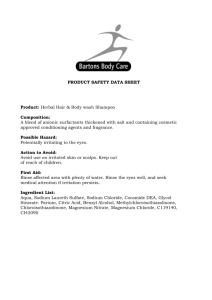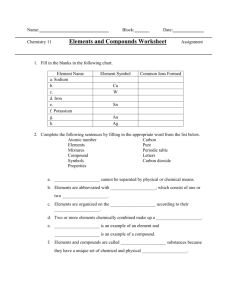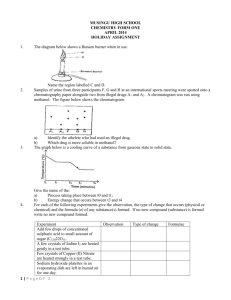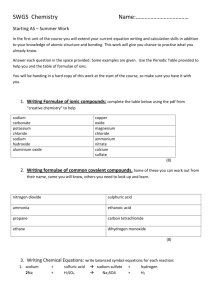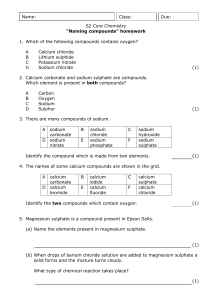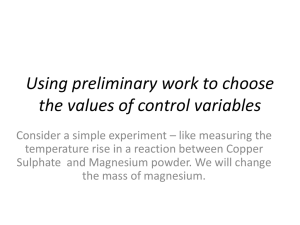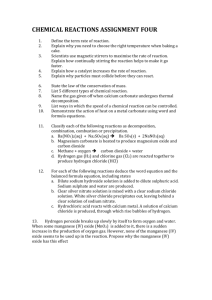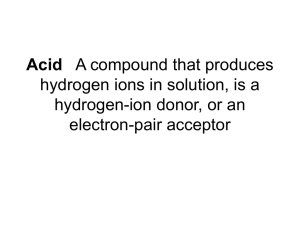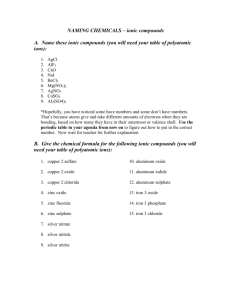Chemical Changes and Structure
advertisement
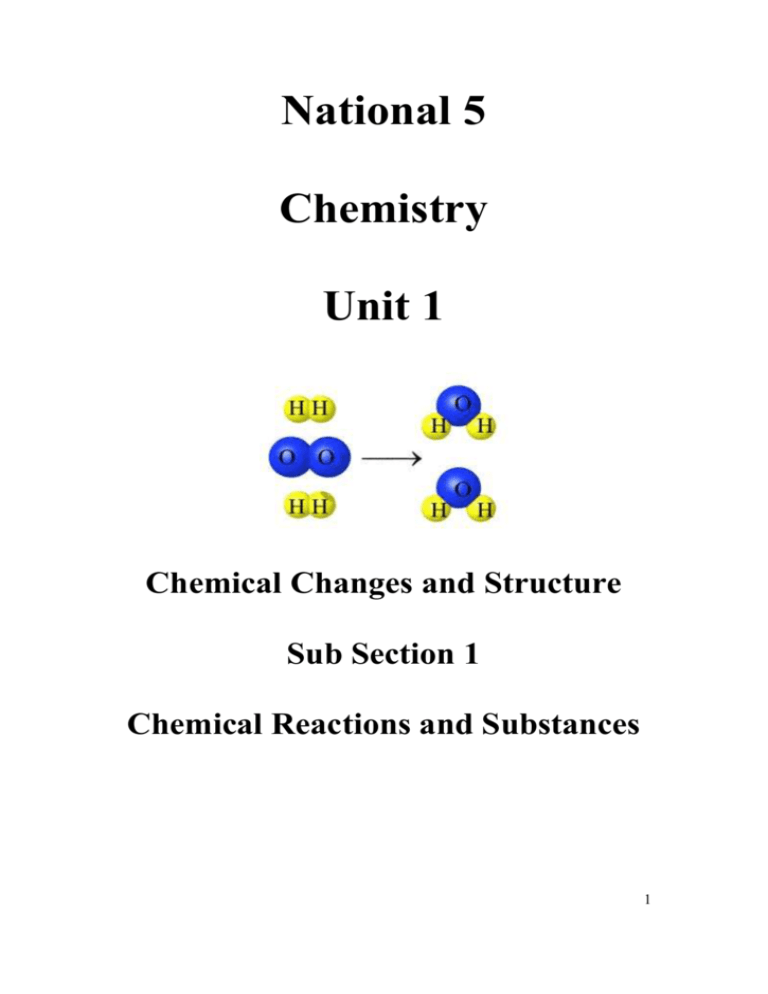
National 5 Chemistry Unit 1 Chemical Changes and Structure Sub Section 1 Chemical Reactions and Substances 1 1. Making new substances What happens when one substance is added to another? Sometimes nothing happens, but at other times a chemical reaction takes place. What happens in a chemical reaction? - The starting substances react together and are changed into new substances. Many chemical reactions are accompanied by a noticeable change in appearance of a substance including - colour changes - gases given off - solids forming. - energy change Activity 1.13 Signs of a Chemical Reaction Follow the instructions to carry out a number of different activities to find out if a chemical reaction has occurred or not. (you may want to make notes in the back of your jotter as you go along) Copy the following table into your notes Substances added together SAFETY What is observed? Chemical reaction (yes or no) Take care with acids and alkalis. 1. Magnesium and copper sulphate solution (a). Add copper sulphate solution to a depth of 2 cm. (b). Add a 1 cm piece of magnesium and shake the mixture. Leave the reaction mixture to settle for a few minutes. 2 Observe what happens. 2 Repeat the above procedure using: 1. vitamin C tablet and water, sand and water, magnesium ribbon ( 1 cm) and hydrochloric acid, copper turnings and hydrochloric acid. Ammonium chloride and calcium hydroxide solids (a). Add 2 spatulafuls of ammonium chloride onto a watch glass. (b) Add 2 spatulafuls of calcium hydroxide and mix the substances together with the spatula. Smell the reaction mixture very cautiously. 4 Repeat this procedure using copper oxide and salt 5 Sodium carbonate and lead nitrate solutions (a) Add sodium carbonate solution to a depth of 2 cm. (b). Add a few drops of lead nitrate solution and leave the reaction mixture to settle for a few minutes. 6. Repeat this procedure using: sodium chloride and potassium nitrate solutions, barium nitrate and sodium sulphate solutions, copper nitrate and potassium chloride solutions. 3 Answer the following questions 1 What is meant by a chemical reaction? 2. What are the 4 ways of recognising that a chemical reaction is taking place? 3. Ensure that you have completed the table Collect Handout 1 and stick it into your notes. Extension Collect a Standard Grade textbook and answer questions 1 and 2. Homework Exercise 1.1 Chemical Reactions 4 2. Energy changes When some substances are added together, nothing appears to happen. However, a chemical reaction may still be taking place. How can we tell? Often this can be detected using a thermometer. This is because all chemical reactions involve energy changes and for some reactions this is great enough to be observed. Exothermic reactions release energy to the surroundings so that the surroundings (and the reaction mixture) heat up. An explosion is a chemical reaction in which a lot of energy is given out in a very short time. Endothermic reactions take in energy from the surroundings so that the surroundings (and the reaction mixture) lose heat, i.e. cool down. Activity 1.14 Energy in a Chemical Reaction Copy and complete the following table. Solutions added together SAFETY Temperature change (yes or no) Chemical reaction (yes or no) Take care with acids and alkalis. Hydrochloric acid and sodium hydroxide solution . 1. Add 20 cm3 of hydrochloric acid to a small beaker. Measure the temperature of the acid. 2. Quickly add 20 cm3 of sodium hydroxide to the acid. Measure the highest temperature reached by the reaction mixture 5 3. Repeat the previous procedure using: hydrochloric acid and nitric acid, sodium chloride and potassium nitrate solutions, sulphuric acid and potassium hydroxide solution. Your teacher may show you a demo of barium hydroxide and ammonium thiocyanate. Answer the following questions 1. If there is no visible sign, what is a way of identifying that a chemical reaction is taking place? 2. What is meant by an exothermic reaction? 3. What is meant by an endothermic reaction? 6 Extension activity 3. A need for energy Some chemical reactions do not take place on their own. For example, photosynthesis needs energy from the sun to make it happen. Energy is often needed to get the reaction going and sometimes to keep it going. Different kinds of energy can be used to start different reactions, e.g. heat energy to start the reaction of magnesium and oxygen, electrical energy to break up copper chloride. Activity 1.15 Energy needs in a Chemical Reaction Copy and complete the table below. Compound heated What is observed Chemical reaction (yes or no) Your teacher will get you to complete a Practical Assessment on ‘Heating Solids’ Use Handout 2 7 Answer the following question What is often needed to start a chemical reaction? Success task / homework Split your page into quarters. In each quarter write one of the following headings At home In school Outside Industry Write down as many chemical reactions as you can for each group. Share your answers with your partner. Combustion Read and complete Handout 3 Making Compounds by Combustion 8 4. Word Equations How can we describe a reaction in a simpler way? So far we have looked at many different chemical reactions. Sometimes, as chemists, it is useful to describe chemical reactions in a simpler way. A word equation is a simpler way to describe a chemical reaction. There are a number of steps to remember when writing a word equation. 1. Draw an arrow in the middle of a line. 2. Write the names of the chemicals we start with on the left of the arrow and separate them by + signs. 3. Write the names of the chemicals that are made on the right of the arrow and separate them by + signs. Look at the example below. When a candle burns, it reacts with oxygen and the new substances that are made are water and carbon dioxide. The word equation for this reaction will be: candle + oxygen water + carbon dioxide Stick NOTES 1.30 into your notes Write a word equation for each reaction below. 1 If silver (I) oxide is heated it can be turned into silver and oxygen. 2 Petrol burns in oxygen to make carbon dioxide and water. 3 Sugar burns in oxygen to make carbon dioxide and water. 9 4 A pupil burned a fuel called “fast gas” and found that carbon dioxide, water and sulphur dioxide were made. (a) Write a word equation for the reaction. Think about the atoms that are present in the new substances. Think about the atoms in the reactants. (b) What does this tell you about the elements that must be present in the “fast gas”? If you are unsure see your teacher for help. (c) Explain your answer to question (b) Complete Exercise 1 10 5. State symbols As we have seen, word equations describe a chemical reaction, but how do I know if we are supposed to use solid copper sulphate or copper sulphate solution in a reaction? It is usual when writing chemical equations to show the states of all the reactants and all the products. (i.e., whether they are solids, liquids or gases) We do this by writing subscripts in the same line as the chemical formula of the substance. The subscripts we use are:(s) stands for solid so copper metal would be written as Cu(s) (g) stands for gas so argon gas would be written as Ar(g) (l) stands for liquids (water, alcohol, mercury) so water is written as H2O(l) (aq) stands for aqueous solutions (dissolved in water) so hydrochloric acid solution is written as HCl(aq) Complete the card sort activity ‘Word Equations’ Homework Exercise 1.14 11 6. Chemical Formula How do we know that the formula of water is H2O? We can work out the chemical formula of a substance easily by following the steps on the FORMULA NOTES sheet. Collect the FORMULA notes sheet and stick it into your jotter. It will make writing formula a lot easier if you remember this table which uses information from the Periodic Table. GROUP 1 2 3 4 5 6 7 8 VALENCY 1 2 3 4 3 2 1 0 Answer the questions on Exercise 2 using the Steps in the Formula Sheet to help you. NB – write down the letters S V S S Use the Formula Sheet to help if you can’t remember what each word means F at the side of the page for each formula, as in the example on the sheet. After you have completed 5 questions check your answers with your partner and analyse any you have got wrong. Do Exercises 2 and 3 12 7. Meaningful names Copy and complete the table below. Prefix Meaning Compound mono carbon monoxide di tri tetra sulphur dioxide sulphur trioxide carbon tetrachloride Formula Now write down the formula of the following compounds: 1. 2. 3. 4. 5. 6. nitrogen dioxide nitrogen monoxide carbon dioxide phosphorus trichloride dinitrogen tetraoxide Carbon tetrafluoride 8. Transition Metals and Group Ions Transition Metals The transition metals do not fit into a group of the periodic Table as in the table used before. Collect NOTES 1.26 and stick it into your notes. Carry out Exercise 4 Group Ions (‘ates’ and ‘ites’) Sometimes atoms exist as a group of atoms which tend to stay together during reactions. Collect NOTES 1.27 and the comples formula sheet and stick them into your jotter. Carry out Exercise 5 13 To do: Draw a cartoon strip that would show that you understand how to either OR (a) write a word equation (b) work out the formula of a compound Extension Standard Grade textbook Page 76 Questions 15.16 and 17 Homework Exercise 1.13 (ii) 14 8 Balanced Chemical Equations Can we make an equation give us even more information ? Now that we are able to write the formula of a compound we can write a balanced chemical equation – this gives us much more information than a word equation as it can be used to tell us how much of each reactant we need in a reaction – and also how much product we could make. Your teacher will use some examples to show you how to balance a chemical equation. Collect NOTES 1.32 (there are 2 sheets) and stick them into your notes. Complete Exercise 6 Extension Standard Grade textbook Page 45 Qu 16 Homework Exercises 1.14, 1.15, 1.16 Summary Task What have I learned ? Design a SUMMARY SHEET to show the steps involved in writing a BALANCED CHEMICAL EQUATION when you have been given a word equation. Your summary can be in the form of a - LEAFLET - FLOW DIAGRAM - POSTER You must include - how to work out the fomula of a compound - transition metals - group ions - how to balance an equation. 15 Consolidation Exercises Exercise 1 Word equations 1. Write each of the following chemical reactions in the form of a word equation. a) Hydrogen joins up with oxygen to make water. b) Carbon dioxide and water vapour are produced when methane gas reacts with oxygen. c) Iron metal is formed when iron oxide is heated with carbon monoxide. Carbon dioxide is also formed. d) In a car engine petrol reacts with oxygen to form carbon dioxide and water vapour. e) The reaction of dilute hydrochloric acid with calcium carbonate produces calcium chloride, carbon dioxide and water vapour. f) Silver oxide breaks up when heated to form the elements. g) Ammonium sulphate is a fertilizer produced by the reaction of ammonia with dilute sulphuric acid. 2. Write a word equation with state symbols for each of the following reactions. a) the reaction of carbon powder with oxygen gas to form carbon dioxide gas b) the reaction of zinc metal with copper sulphate solution to form copper metal and zinc sulphate solution c) the reaction of magnesium metal with oxygen gas to form the powdered compound d) the reaction of sodium metal with water to form sodium hydroxide solution and hydrogen gas e) the reaction of barium chloride solution with sodium sulphate solution to form solid barium sulphate and sodium chloride solution 16 Exercise 2 Using the Periodic Table Write the formula for each of the following compounds. a) b) c) d) e) f) g) h) Exercise 3 hydrogen chloride phosphorus hydride nitrogen fluoride silicon hydride silicon oxide hydrogen sulphide nitrogen hydride silicon chloride Using the Periodic Table Write the formula for each of the following compounds. a) potassium chloride b) calcium fluoride c) sodium sulphide d) calcium oxide e) aluminium sulphide f) magnesium fluoride g) lithium bromide h) aluminium chloride i) magnesium nitride 17 Exercise 4 Using Roman numerals Write the formula for each of the following compounds. a) b) c) d) e) f) g) iron(III) chloride copper(II) oxide copper(I) chloride iron(II) bromide lead(I) oxide vanadium(V) oxide copper(II) bromide h) lead(IV) oxide Exercise 5 Using group ions Write the formula for each of the following ionic compounds. a) b) c) d) e) f) g) h) i) j) k) l) m) n) o) p) sodium sulphate potassium nitrate calcium carbonate magnesium hydroxide ammonium chloride lithium sulphate aluminium carbonate lithium carbonate ammonium hydroxide aluminium hydroxide ammonium sulphate sodium phosphate potassium hydroxide radium sulphate sodium sulphite ammonium carbonate 18 Exercise 6 1. Balanced chemical equations Balance each of the following chemical equations. a) H2 + Cl2 → HCl b) N2 + O2 → NO2 c) Al + Cl2 → AlCl3 d) C3H8 + O2 → CO2 e) H2 + O2 → H2O f) Ca + H2O → Ca(OH)2 g) Fe2O3 + CO → h) NH3 + O2 i) C2H6 + j) NaOH + + H2O Fe + CO2 → NO + H2O O2 → CO2 + H2O H2SO4 → Na2SO4 + H2O 2. Write word equations for each of the following reactions and hence write balanced chemical equations. a) the burning of carbon to give carbon dioxide b) the burning of calcium c) the formation of magnesium nitride from its elements d) the formation of titanium(IV) chloride from its elements e) the decomposition of hydrogen bromide f) the formation of sulphur trioxide from sulphur dioxide and oxygen g) the burning of silicon h) the decomposition of nitrogen hydride to produce the elements i) the decomposition of silver(I) oxide 19 Exercise 7 Using symbols and formulae Use symbols and formulae to write a balanced chemical equation, with the state symbols, for each of the following reactions. a) carbon monoxide gas + oxygen gas b) sodium metal + water c) lead(II) + nitrate e) aluminium metal f) iron metal g) magnesium + h) nitrogen gas + + → lead(II) chloride solid + potassium nitrate solution calcium oxide powder → oxygen gas chlorine gas → i) ammonia + (nitrogen hydride) gas hydrogen gas sulphuric acid, H2SO4(aq) barium + sodium chloride sulphate → + carbon dioxide gas aluminium oxide solid iron(III) chloride solid → nitric acid, HNO3(aq) + carbon dioxide gas sodium hydroxide solution + hydrogen gas potassium → chloride solution d) calcium carbonate powder j) → → → → magnesium + hydrogen nitrate solution gas ammonia gas ammonium sulphate solution barium + water + sodium chloride sulphate 20 National 5 Elements, Compounds and Mixtures 21 1. Elements 1.1. Organising Elements – The Periodic Table Are all the elements in the known world the same? Students in school are gathered together by age and subject being studied to form a class. In a supermarket, similar foods are gathered together, e.g. fruit, cereals, meat. When we are faced with a wide variety of things we often try to gather together those which have something in common. This is called classification. Elements are the building blocks of all substances in the world just as bricks are the building blocks of houses. Just over 100 different elements are known. There are different ways of gathering the elements together so that all the elements in the one "class" have something in common. Modern-day chemists have classified elements by arranging them in the Periodic Table. Activity 1.1 Using the information above answer question 1 & 2 over the page. Now look at samples of some of the elements also look at a suitable Periodic Table. Complete the 3 tables over the page as you go through the 6 stages of the activities. 22 1. Find some - shiny elements, coloured elements. 2. Find some - metal elements, non-metal elements. 3. Find some elements which are - solid at room temperature, - liquid at room - gas at room temperature. 4. Find some elements which are - naturally occurring, made by scientists. 5. Find some elements which are - stored under oil. 6. Find some elements which are - named after a planet, named after a scientist, named after a place. temperature, 23 Questions: 1. Approximately how many different elements are known? 2. What name is given to the modern-day arrangement of elements? 3. Copy and complete the following tables. Include a number of elements under each heading. Solid Liquid Gas Metal Non-metal Naturally occurring Made by scientists 1.2 Chemical symbols Why does sodium not have the symbol S? A chemical symbol is a "shorthand" way of representing an element. Each element has its own chemical symbol. The ancient chemists (or alchemists) were the first to use symbols for elements in place of their names, e.g. Modern symbols for elements consist of one or two letters. The first letter is always a capital letter; the second is always a small letter. A few elements have symbols which come from the Latin name. For examples the Latin name for sodium is natrium and for silver it is argentum. 24 Activity 1.2 Elements and Symbols Look at a suitable Periodic Table and use text book page…. to find some elements which have a symbol that is the first letter of its name, that is the first two letters of its name, that comes from its Latin name. 1. Copy and complete the following table remembering that a capital letter is used for the symbol. Element Symbol hydrogen C iodine N sulphur V 2. Copy and complete the table below remembering that only the first letter of the symbol is a capital letter. Element Symbol chlorine Mg calcium Sc argon Si 3. What is the symbol for helium? 4. Why is it not just H? 5. What is the symbol for cadmium? 6. Why is it not just C or Ca? 25 7. Copy and complete the following table. Element Symbol Latin name gold silver iron sodium potassium Extension: Make up your own element with its own unique properties and symbol. Describe it to your teacher when you have finished. Families of elements – Groups in the Periodic Table 1.3 Some elements are very reactive; others are quite unreactive. Elements are arranged into ‘families’ with similar properties called groups. Activity 1.3 – Reactivity of Group 1 Metals Your teacher will carry out a demonstration to show the reactivity of group 1 metals in water. They will also show you a short DVD(1) about Group 7 and 8 elements. Take a copy of Notes 1.1 and stick it into your notes after completing it. 1. How are the alkali metals stored? 2. Why are they stored in this way? 3. Describe the reactions of the alkali metals with water. 4. Describe a reaction involving chlorine. 5. Why are the noble gases often referred to as the inert gases? 26 2. Compounds and mixtures Are you made up of compounds or a mixture of elements? 2.1 Compounds Most of the substances which exist in the world are not pure elements - they are compounds. A compound is made up of two or more elements which are chemically joined together. Since they are joined together it is difficult to separate out the elements which make up the compound. Energy must be supplied to do this. Some elements, e.g. carbon and oxygen, are found in lots of compounds; other elements make very few compounds. Activity 1.4 Look at the display of substances. Identify the substances which are 1. - pure elements - compounds. What is meant by a compound? 2. Is it easy to separate out the elements which make up a compound? Explain. 3. Copy and complete the following table for the substances in the display. Element Compound 27 2.2 Making and breaking compounds a) Making magnesium oxide A compound is very different from the elements which make it up, e.g. sugar (a white solid) is made from carbon (a black solid) and hydrogen and oxygen (both colourless gases). Magnesium oxide can be made by burning magnesium in oxygen. Activity 1.5 Safety: DON'T LOOK DIRECTLY AT BURNING MAGNESIUM. THE BRIGHT LIGHT COULD DAMAGE YOUR EYES. 1. Using tongs, hold a piece of magnesium ribbon (3 cm) in a Bunsen flame until it 1. Copy and complete the following table. burns. Name and Elements 2. Remove the product from the flame Appearance examine it. reacting Compound 28 (b) Breaking up copper chloride Electricity can be used to break up copper chloride into its elements. This process is called electrolysis. Activity 1.6 1. Half-fill a small beaker with water. 2. Add a few spatulafuls of copper chloride. Stir until it all dissolves. 3. Gently clean the carbon electrodes with sandpaper. 4. Set up the apparatus shown. 5. Identify the products at the positive and negative electrodes. 1. What form of energy is used to break up the compound? 2. What is the process called of breaking up a compound using electricity called? 29 3. Copy and complete the following table. Name Appearance Elements formed Compoun d 2.3 Naming of compounds Important Rules for Naming Compounds: Compounds containing only two elements have names ending in -ide, e.g. sodium chloride contains only sodium and chlorine. Compounds containing more than two elements, one of which is always oxygen, have names ending in -ate or -ite, e.g. copper sulphate contains copper, sulphur and oxygen. Activity 1.7 1. Compounds containing only two elements have what name ending? 2. Compounds containing two or more elements, one of which is oxygen, usually have one of what two name endings. 3. Name the elements which can be found in the following compounds: Answer questions 1 & 2 below. Then look at compounds in the display. Using the rules above identify the elements in each of the compounds and fill out the table in question 3. Lithium fluoride Magnesium nitride 30 4. Potassium sulphate Calcium chloride Magnesium carbonate Lithium sulphite Potassium oxide Sodium chlorate Aluminium phosphate Copy and complete the following table for the compounds in the display. Compound 2.4 Element present Mixtures Did you know that air is a mixture of gases! But what gases are in air? Very few substances in nature are found on their own - they are usually mixed with other substances. A mixture contains two or more substances which have come together without reacting; the properties of a mixture are the same as those of the substances in it. Different elements are chemically joined together in a compound; the properties of a compound are different from those of the elements which make it up. 31 Activity 1.8 Look at the samples of pure sulphur, pure iron. Now you can help your teacher to demo the difference between a mixture of iron and sulphur and a compound of iron and sulphur. A magnet can be used to demonstrate this. 1. 2. What is the main difference between a mixture and a compound? Draw diagrams to show this difference. 3. Describe how to separate a mixture of iron and sulphur. Explain. 4. Can iron be separated from a compound of iron and sulphur using a magnet? Explain. 5. What is the name of the compound made by sulphur and iron? 6. Activity: Filtration: Separating a solid from a Liquid Can you think where you would use filters in your home? This is an assessable technique. Filtration apparatus: 32 Insoluble solid (residue) is trapped in the paper Filter Paper Filter Funnel Instructions: 1. 2. 3. Collect two clean beakers, filter paper, a filter funnel and a retort stand. Set up the apparatus as set out above. Take the filter paper and fold it in half, then half again. Open it up (it should be a cone shape). Wet the paper slightly and place it in the filter funnel. 4. With the second beaker collect some dirty water from the trolley. 5. Filter the dirty water. 6. Collect a Practical Technique write up sheet and complete it. 2.4 More Mixtures - Air The air around us is an example of a mixture of gases. Dry air contains approximately 78% nitrogen, 21% oxygen and small amounts of carbon dioxide, helium, neon, argon and xenon. Oxygen gas is produced when potassium permanganate is heated. This can be used to find the test for oxygen. 33 Activity 1.9 – Testing for Oxygen SAFETY In this experiment you MUST check with your teacher before starting. 1. Clamp at the mouth. Test-tube is horizontal. 2. Add 2 spatulafuls of potassium permanganate followed by a loose plug of rocksil wool. 3. Gentle heat until potassium permanganate begins to 'crackle'. Check what happens to a glowingsplint held in the test-tube. 1. Draw a table showing the mixture of gases in air and the percentage (%) they make up. 2. Describe the test for oxygen. 3. Why does the oxygen in the air not give a positive result to this test? 2.5 More Mixtures - Solutions (a) Solute, solvent and solution 34 A solution is a mixture of a solute which is dissolved in a solvent. Sea water is an example of a solution. The salt is the solute and the solvent is the water. Together they make a sea water solution which is a mixture. You cannot see the salt in sea water, but it can be tasted. Activity 1.10 1. Add about 20 cm3 of water (the solvent) to an evaporating basin 2. Add three spatulafuls of salt (the solute) Stir until it all dissolves. When a solute dissolves in a solvent to form a solution, no new substance is formed. Solutions are therefore mixtures. 3. Gently heat the solution on a to solution, the solvent is water. Substances which are In antripod aqueous evaporate water and recover insoluble in waterthe may be soluble in other solvents, e.g. turpentine the salt.solvent for paint, acetone dissolves nail polish. is a suitable 1. Is it easy to separate a solute and solvent from a solution? 2. Write a brief not on how this is done. 3. Using a Chemistry Text book find out the full definitions of solute, solvent and solution and write them into your notes. 35 (b) Dilute, concentrated and saturated How do you turn a concentrated solution of orange juice into a dilute solution of orange juice? Activity 1.11 – Making a Dilute, Concentrated and Saturated Solution 1. Add about 10 cm3 of water to each of five test-tubes. 2. To the first test-tube add 1 spatulaful of copper sulphate to make a dilute solution. 3. To the second test-tube add 2 spatulafuls of copper sulphate and so on to make successively more concentrated solutions. Carefully shake each test-tube to dissolve as much copper sulphate as possible. 4. Observe the colours of the solutions. Note which test-tubes contain undissolved copper sulphate (saturated solution) 5. Dilute the solutions by adding a further 10 cm 3 of water to each of the five test-tubes. Again carefully shake each test-tube to dissolve as much copper sulphate as possible. 6. Observe what happens to the colours of the solutions. Note which test-tubes now contain saturated solutions. Take a copy of Notes 1.2 and stick it into your notes after completing it. 36 Consolidation Activity: Elements, Compounds and Mixtutres. 1. Collect a Standard Grade Text book and read pages 3 to 7 answering questions 1, 2 and 3 along the way. 2. Turn to page 8 in the text book and answer questions 3 to 10. 37
